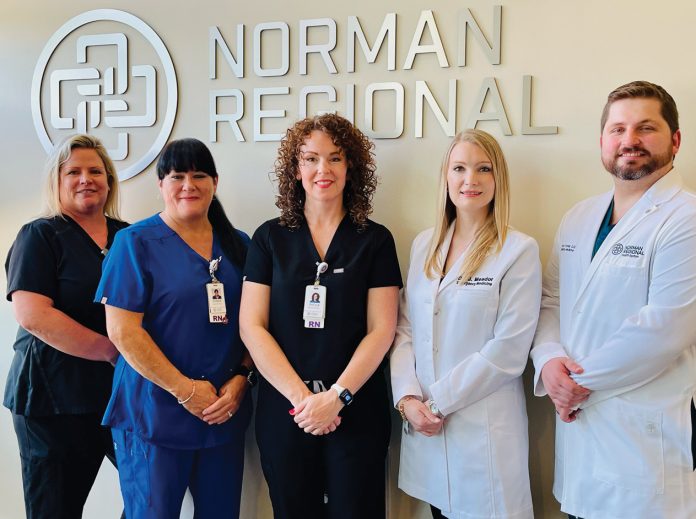
by Bobby Anderson, Staff Writer
Globally, it’s estimated there are more than 27 million human trafficking victims at any given time.
These victims often pass by unseen every day. Unfortunately, those victims also pass through our healthcare system at an alarming rate, undetected by nursesand doctors.
That was alarming for Norman Regional Health System’s Sheila Monson, BSN, RN.
A comment by a travel nurse actually got Monson thinking about the epidemic in a different way. (story continues below)
Monson was charging in the emergency room one shift and working triage.
“You know you kind of have a feeling that something is wrong but (this patient) wasn’t talking, wasn’t telling me anything. I just knew something was off,” Monson said.
The travel nurse went to see the patient next and agreed something was amiss. That’s when she asked Monson about the system’s human trafficking protocols.
She explained several major systems she had worked for had human trafficking protocols that began with a screening tool.
That’s when Monson got to thinking – and researching.
Monson found research that showed some 88 percent of victims reported they had received medical treatment some time during their ordeal. Of those encounters, 64 percent occurred in an ER setting.
None of those encounters resulted in the patient being detected as being trafficked.
“I thought holy cow, ER is the biggest,” Monson said. “We probably need to do something.”
Monson created a PowerPoint presentation and took it to her emergency department’s Unit-Based Council as part of the hospital’s shared governance system.
“We’re not even looking for these people and they’re right in front of us and we’re not helping them,” Monson said. “We took a vote and said this is what we wanted to do. We took it to leadership and they supported us and told us (we had) whatever we needed.”
Monson called ERs around the state and tried to get their protocols to help shape the health system’s.
“Nobody knew what I was talking about,” she said. “I feel like this is something every ER nurse should have (access to).”
With four ERs in the system, Monson realized something needed to be streamlined for NRH nurses.
While researching, she discovered the Department of Health and Human Services coordinates its Blue Campaign to increase awareness of the problem.
The American Hospital Association did a study with emergency medicine to identify a list of top 10 red flags for trafficking.
“They said usually these top 10 are identified in the triage setting,” Monson said. “The triage setting is a six-minute process and they’re in and out. Within that six-minute interaction nurses are identifying red flags.”
Monson was able to get the top 10 indicators loaded into the hospital’s triage software with one crucial question asking the triage nurse if they suspect trafficking. If that question is marked yes an immediate notification is put up on the system’s internal tracking system.
“Everybody in the back can see it when it pops up,” Monson said. “It cues the staff in the back to do further testing and look for further red flags.”
From there, Monson and her nurses visited departments that would further interact with the patient such as lab, radiology, and transportation staff.
“Now we’re looking for it and we’re acutely aware of what could be going on,” Monson said.
A space within each emergency department was identified as a location where staff could separate the patient from their suspected trafficker in order to give the patient an opportunity to receive additional help if they chose.
The patient is provided with resources for local shelters and the human trafficking crisis center. Staff were educated on these methods at monthly meetings, and the Emergency Medicine residents received specific training by the local human trafficking crisis center on how to identify potential victims.
In the first month of implementation, 14 potential Human Trafficking Victims were identified in triage.
Unfortunately, staff reported many barriers to further screening and interventions- including patient and staff safety, inability to separate the potential victim from the trafficker, difficulty distinguishing between domestic violence and HT, and staff concern for creating more trauma for victims.
Going forward, Monson said several system-wide changes were made to address these barriers. Staff created a discrete information sheet (available in English and Spanish) disguised as a Chapstick container that can be given to potential victims.
An easily accessible, printable sheet was placed in the electronic health record that contains information and resources for labor and sex trafficking available in 23 languages.
Now, all new employees in the hospital are required to complete education on human trafficking during the onboarding process.
The hospital system is currently partnering with several internal and community resource providers to raise awareness on the importance of identifying and intervening on this often-overlooked human rights issue.
“Even if you suspect it, just give the resources,” Monson said. “Our goal now is to just pass off the resources, give them the tools they need so when they’re ready for help they’ve got it.” For more information about Norman Regional Health System, visit https://careers.normanregional.com/careers-home/.











